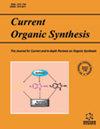The Second Omega Index
IF 2.5
4区 化学
Q3 CHEMISTRY, ORGANIC
引用次数: 0
Abstract
Background: The omega index has been recently introduced to identify a variety of topological and combinatorial aspects of a graph with a new viewpoint. As a continuing study of the omega index, by considering the incidence of edges and vertices to the adjacency of the vertices, in this paper, we have introduced the second omega index Ω2 and then computed it over some well-known graph classes. Methods: Many combinatorial counting methods have been utilized in the proofs. The edge partition is frequently used throughout the work. Naturally, some graph theoretical lemmas are also used. Results: In particular, trees having the smallest and largest Ω2 have been constructed. Finally, the second omega index of some derived graphs, such as line graphs, subdivision graphs, and vertex-semitotal graphs, has been presented. Conclusion: Omega invariant has already been explored in many papers. It has been defined in terms of vertex degrees. Vertices correspond to the atoms in a molecule and a calculation, which only depends on the atomic parameters, is not even comparable with a calculation containing both atoms and chemical bonds between them. With this idea in mind, we have evaluated some mathematical properties of the second omega index, which has great potential in chemical applications related to the number of cycles in the molecular graph.第二个欧米茄索引
背景:欧米茄指数(omega index)是最近提出的一种以新观点识别图的各种拓扑和组合方面的指数。作为对欧米伽指数的继续研究,通过考虑边和顶点的入射关系与顶点的邻接关系,我们在本文中引入了第二个欧米伽指数Ω2,并在一些著名的图类中对其进行了计算。方法:证明中使用了许多组合计数方法。在整个工作中经常使用边分区。当然,也使用了一些图论定理。结果特别是构建了具有最小和最大 Ω2 的树。最后,提出了一些派生图的第二Ω指数,如线图、细分图和顶点-半总图。结论许多论文已经探讨了欧米伽不变性。它是用顶点度来定义的。顶点对应于分子中的原子,而仅取决于原子参数的计算甚至无法与同时包含原子和原子间化学键的计算相提并论。考虑到这一点,我们对第二欧米茄指数的一些数学特性进行了评估,该指数在与分子图中的循环数有关的化学应用中具有巨大潜力。
本文章由计算机程序翻译,如有差异,请以英文原文为准。
求助全文
约1分钟内获得全文
求助全文
来源期刊

Current organic synthesis
化学-有机化学
CiteScore
3.40
自引率
5.60%
发文量
86
审稿时长
6-12 weeks
期刊介绍:
Current Organic Synthesis publishes in-depth reviews, original research articles and letter/short communications on all areas of synthetic organic chemistry i.e. asymmetric synthesis, organometallic chemistry, novel synthetic approaches to complex organic molecules, carbohydrates, polymers, protein chemistry, DNA chemistry, supramolecular chemistry, molecular recognition and new synthetic methods in organic chemistry. The frontier reviews provide the current state of knowledge in these fields and are written by experts who are internationally known for their eminent research contributions. The journal is essential reading to all synthetic organic chemists. Current Organic Synthesis should prove to be of great interest to synthetic chemists in academia and industry who wish to keep abreast with recent developments in key fields of organic synthesis.
 求助内容:
求助内容: 应助结果提醒方式:
应助结果提醒方式:


